Do you have a question about the York MILLENNIUM YCAL0043SC and is the answer not in the manual?
Information subject to change without notice; verify applicability with YORK Service.
Hazards during operation, maintenance, or service; protect yourself and work safely.
High voltage is used; death or serious injury may result from failure to observe safety precautions.
Low voltages, even 50 volts, can cause death; do not be misled by the term 'low voltage'.
Explains how to identify the basic model number and its components.
Details the structure and meaning of each digit in the basic model number.
Provides a detailed breakdown of optional features and their codes.
Diagram showing the refrigerant flow with components and sensors.
Guidance on lifting and handling the unit to prevent damage.
Procedures for inspecting the unit for shipping damage upon receipt.
Recommendations for unit placement and required clearances for operation and maintenance.
Items to check before placing the unit into operation.
Requirements for the unit's foundation, floor, or rooftop mounting.
Considerations for installing the unit at ground level, including base and security.
Guidance on selecting a rooftop location and structural support.
Advice on locating the chiller to minimize noise impact in sensitive areas.
Information on optional spring isolators for vibration reduction.
Details on how compressors are mounted using rubber isolators.
General guidelines for connecting chilled water piping, ensuring cleanliness and proper flow.
Specific considerations for chilled water piping, including stop valves, hose loops, and drain connections.
Instructions for field wiring power supply and control panel connections.
Details on terminal block contacts for evaporator pump start signals.
Information on auxiliary contacts for monitoring system status.
Normally-open contacts for indicating system normal or fault status.
Wiring for remote start and stop functionality using dry contacts.
Procedure for immediate chiller shutdown via field-installed dry contact.
Details on using PWM input for chilled liquid setpoint reset.
Information on using load limit input to prevent exceeding desired values.
Wiring for the flow switch input to CTB1 terminals.
Diagram showing standard power supply wiring connections.
Diagram for optional single point power supply wiring for specific models.
Wiring diagram for optional single-point power supply with N-F disconnect or circuit breaker.
Diagram illustrating control wiring connections for various functions.
Important notes regarding electrical installation, circuit ampacity, and wiring.
Defines abbreviations and terms used in electrical notes and diagrams.
Table detailing voltage, control power, MCA, and overcurrent protection.
Details standard power connections for single and dual point wiring.
Table showing system wiring, compressor, and fan data for single point power.
Table detailing optional single point power wiring configurations.
Table showing operational limits for leaving water temp, cooler flow, and air on condenser.
Absolute voltage limitations that must not be exceeded to prevent compressor damage.
Table listing minimum and maximum allowable unit voltages.
Curves illustrating cooler pressure drop based on water flow.
Factors for correcting performance when using ethylene glycol.
Table showing operational limits for leaving water temp, cooler flow, and air on condenser in metric.
Absolute voltage limitations that must not be exceeded to prevent compressor damage.
Table listing minimum and maximum allowable unit voltages in metric.
Curves illustrating cooler pressure drop based on water flow in metric units.
Factors for correcting performance with ethylene glycol in metric.
Detailed physical data including dimensions, weight, and refrigerant charge.
Detailed physical data including dimensions, weight, and refrigerant charge in metric.
Diagrams showing unit dimensions and clearance requirements.
Table showing weight distribution and center of gravity for specific models.
Diagrams showing unit dimensions and clearance requirements.
Table showing weight distribution and center of gravity for specific models.
Diagrams showing unit dimensions and clearance requirements.
Table showing weight distribution and center of gravity for specific models.
Diagrams showing unit dimensions and clearance requirements.
Table showing weight distribution and center of gravity for specific models.
Diagrams showing unit dimensions and clearance requirements in millimeters.
Table showing weight distribution and center of gravity in kilograms and millimeters.
Diagrams showing unit dimensions and clearance requirements in millimeters.
Table showing weight distribution and center of gravity in kilograms and millimeters.
Diagrams showing unit dimensions and clearance requirements in millimeters.
Table showing weight distribution and center of gravity in kilograms and millimeters.
Diagrams showing unit dimensions and clearance requirements in millimeters.
Table showing weight distribution and center of gravity in kilograms and millimeters.
Essential checks to perform before initial startup of the chiller unit.
System checks performed with no power applied, focusing on piping and visual inspections.
Specific unit checks required before initial startup, including shipping damage and oil levels.
Checks to be performed on the control panel after power application but before unit activation.
List of programmable options and cooling setpoints available for configuration.
Steps to follow for the initial startup of the chiller after pre-startup checks are complete.
Procedures for checking and calculating superheat and subcooling for refrigerant charging.
Recording liquid line pressure, temperature, and subcooling for system analysis.
Procedure for performing leak checks on compressors, fittings, and piping.
Describes the sequence of operation for the chiller, including startup and compressor staging.
Overview of the YORK MicroComputer Control Center and its components.
Description of the microprocessor-based control system and its functions.
Details the controller, inputs, outputs, and integrated circuitry of the control panel.
Description of the 12-button keypad for system monitoring and configuration.
Information on the Real Time Clock and its battery backup function.
How to determine current chiller operating status via the STATUS key.
Explanation of status messages displayed when the STATUS key is pressed.
Common status messages indicating system operational states and shutdowns.
Indicates that a system switch under OPTIONS is turned off.
Indicates low liquid temperature or insufficient loading for system operation.
Shows the number of compressors running in a system due to demand.
Displays the remaining time on the system's anti-recycle timer.
Indicates the anti-coincident timer status for two-system units.
Indicates that discharge pressure limiting is active due to high load conditions.
Indicates suction pressure limiting is active, preventing loading beyond a set point.
Shows the percentage of load limiting currently in effect.
Manual override mode for emergencies or servicing, disabling daily schedule.
Indicates a compressor is in the process of pumping the system down.
Categorizes faults into system safeties and unit safeties.
Faults that cause individual systems to shut down, with auto-reset and lockout conditions.
Discharge pressure cutout fault due to high system pressure.
Suction pressure cutout fault protecting against evaporator freeze-up.
Motor protector or high pressure cutout fault for compressor protection.
Faults causing all running compressors to shut down, with auto-reset and lockout conditions.
Shutdown due to low outdoor ambient temperature.
Shutdown due to low chilled liquid temperature, preventing evaporator freeze-up.
Shutdown due to low voltage at the micropanel, preventing microprocessor damage.
Non-safety warning messages requiring operator intervention, like low battery.
Categorized list of status messages displayed via the STATUS key.
Flowchart categorizing status messages into General, System Safeties, and Unit Safeties.
Messages indicating general unit status like switch positions or cooling load.
Messages related to system safeties and unit safeties.
Using Display/Print keys to retrieve and print system and unit information.
Accessing unit and system operating parameters via the OPER DATA key.
Display showing system 1 suction and discharge pressures.
Display showing unit load and unload timers in seconds.
Indicates the current step in the capacity control scheme.
Indicates the current lead system for dual-system units.
Displays the status of the evaporator pump and heater.
Shows system run time in days, hours, minutes, and seconds for the current cycle.
Indicates the active stage of condenser fan operation.
Flowchart detailing the sequence of operation data screens accessible via the OPER DATA key.
Obtaining printouts of real-time data or fault information using the PRINT key.
How to obtain a printout of current system operating parameters.
Obtaining a printout of the last 6 safety shutdowns and associated conditions.
Accessing unit and system parameters at the time of a safety shutdown.
Display showing the programmed low ambient temperature cutout value.
Display showing system suction and discharge pressures.
Details the Entry keys (UP, DOWN, ENTER/ADV) for navigating and programming.
Used with OPER DATA and HISTORY keys for scrolling data screens.
Key used to enter changes into memory and advance to the next parameter.
Instructions for programming cooling setpoints, schedules, and safeties.
Indicates cooling setpoint is under local control based on leaving water temperature.
Indicates cooling setpoint is under local control based on return water temperature.
Indicates cooling setpoint determined by a remote device using leaving water temperature.
Indicates cooling setpoint determined by a remote device using return water temperature.
Table showing programmable limits and default values for cooling setpoints.
Programming a seven-day schedule with start/stop times and holiday settings.
Display showing holiday schedule start and stop times.
Accessing and programming six operating parameters including pressure cutouts and timers.
Setting the discharge pressure threshold for system shutdown.
Setting the suction pressure threshold to prevent evaporator freeze-up.
Setting the low ambient temperature cutout point.
Setting the leaving chilled liquid temperature cutout.
Setting the minimum time between compressor starts to prevent short cycling.
Setting the pressure threshold for staging condenser fans ON.
Setting the pressure differential for staging condenser fans OFF.
Displaying the total number of compressors in the chiller.
Table of programmable values, their limits, and defaults.
Quick reference chart for setpoints accessible via Cooling Setpoints, Schedule/Advance Day, and Program keys.
Programming and configuring unit options using the UNIT key.
Navigating and changing programmable options for the unit.
Selecting the display language for the control panel.
Enabling or disabling system switches for dual-system units.
Selecting the unit type, such as Liquid Chiller or Condensing Unit.
Specifying whether the chilled liquid is water or glycol.
Selecting standard or low ambient control for condenser fan operation.
Choosing between local control or remote control via ISN or RCC.
Setting the control mode based on return or leaving chilled liquid temperature.
Selecting imperial or SI units for display messages.
Configuring lead/lag control for systems to equalize compressor run time.
Selecting condenser fan control based on ambient temp/discharge pressure or discharge pressure only.
Enabling or disabling manual override of the daily schedule for service.
Setting and verifying the current day, time, and date for proper scheduling.
Quick reference chart for programming unit options via the UNIT key.
Explanation of how the chiller manages cooling load through compressor staging.
Control strategy for maintaining setpoint based on leaving chilled liquid temperature.
Diagram illustrating leaving water temperature control and compressor staging.
Table showing compressor staging for 6-compressor units with leaving chilled liquid control.
Table showing compressor staging for 4-compressor units with leaving chilled liquid control.
Table showing compressor staging for 3-compressor units.
Table showing compressor staging for 2-compressor units.
Control strategy for dual-system units based on return chilled liquid temperature.
Table showing compressor staging for return water control with 6 compressors.
Table detailing return chilled liquid control for 6 compressors.
Table detailing return chilled liquid control for 4 compressors.
Conditions under which the evaporator pump is energized.
Control logic for the evaporator heater based on ambient air temperature.
Programming condenser fan control based on ambient temp/discharge pressure or discharge pressure only.
Table defining condenser fan control logic based on ambient and discharge pressure.
Table defining condenser fan control logic based on discharge pressure only.
Operation of condenser fans with a low ambient kit installed.
Fan control logic for low ambient conditions using ambient and discharge pressure.
Fan control logic for low ambient conditions using discharge pressure only.
Description of the pump-down feature and LLSV operation upon system shutdown.
Feature to prevent unit loading beyond a desired value, with stages and methods explained.
Indicates compressor run status via closure of contacts at CTB2.
Indicates system or unit shutdown via alarm contacts opening.
Logic for equalizing run hours and starting compressors based on least run time.
Table showing load limiting permitted for different numbers of compressors.
Resets chilled liquid setpoint based on PWM input from an Energy Management System.
Using 0-10 VDC, 4-20mA, or contact closure inputs for remote temperature reset.
Diagram of electrical connections for the optional remote temperature reset board.
Steps to clear the unit's history buffers.
How to view the software version of the control board.
Mode allowing viewing and modification of unit inputs and outputs.
Navigating and controlling digital outputs within Service Mode.
Viewing digital and analog inputs to the microboard in Service Mode.
List and description of analog inputs like pressure and temperature sensors.
List and description of binary inputs like switches and contacts.
References to tables and figures detailing microboard connection points.
List of microboard binary inputs, their connections, and functions.
List of microboard analog inputs, their connections, and functions.
List of microboard outputs, their connections, and functions.
Diagram showing the physical layout and connections on the microboard.
How to check binary inputs, voltage sources, and connections.
Checking analog temperature inputs and their corresponding voltage readings.
Connections and voltage readings for the outdoor air temperature sensor.
Table correlating outdoor air temperature with sensor voltage and resistance.
Connections and voltage readings for the entering chilled liquid temperature sensor.
Connections and voltage readings for the leaving chilled liquid temperature sensor.
Table correlating chilled liquid temperatures with sensor voltage and resistance.
Checking analog pressure inputs and their corresponding voltage readings.
Microboard connections for System 1 discharge pressure transducer.
Microboard connections for System 2 discharge pressure transducer.
Microboard connections for System 1 suction pressure transducer.
Microboard connections for System 2 suction pressure transducer.
Microboard connections for System 1 low pressure switch.
Microboard connections for System 2 low pressure switch.
Referencing digital outputs located on TB3, TB4, and TB5.
Diagram illustrating the microboard relay contact architecture.
Table mapping keypad buttons to their corresponding pin connections.
Description of how the operator keypad connects to the microboard.
Instructions for installing an optional printer for chiller data and fault printouts.
List of required parts for installing the WEIGH-TRONIX printer.
Instructions for assembling and wiring the printer connection cable.
Procedure for obtaining printouts using the PRINT key and OPER DATA or HISTORY keys.
Diagram showing electrical connections between the printer and the microboard.
Table listing problems, causes, and solutions for chiller operation.
Troubleshooting steps for no display or unit non-operation.
Troubleshooting a 'No Run Permissive' fault related to flow switch or remote controls.
Troubleshooting steps for low suction pressure faults.
Continued troubleshooting for low suction pressure faults, including TXV and flow issues.
Troubleshooting steps for high discharge pressure faults.
Troubleshooting steps for low chilled liquid temperature faults.
Troubleshooting compressor motor protector or high pressure cutout faults.
Troubleshooting steps when compressors fail to start.
Troubleshooting steps for issues causing lack of cooling effect.
Disclaimer regarding YORK's liability for costs due to improper maintenance.
Procedures for checking compressor oil level and oil analysis.
Information on condenser fan motor lubrication and maintenance requirements.
Recommendations for cleaning condenser coils to maintain efficiency.
Ensuring operating temperatures and pressures are within limitations.
Procedure for conserving battery power by turning off the clock when the unit is off.
Periodic inspection of the unit for proper operation and component integrity.
Information on using the ISN (Intelligent System Network) for control and monitoring.
Description of data received from the ISN for remote control parameters.
Table listing control data received from the ISN.
Information on data transmitted from the unit to the ISN.
Table listing data values and page listings transmitted to the ISN.
Continued table listing data values and page listings transmitted to the ISN.
Table defining ISN operational and fault codes for system status.
Control circuit elementary diagram for YCAL0043SC - YCAL0087SC models.
Diagram of the control circuit, showing components and connections.
Continued control circuit diagram for YCAL0043SC - YCAL0087SC models.
Power circuit elementary diagram for YCAL0043SC - YCAL0087SC models.
Diagram of the power circuit, showing electrical connections and components.
Diagram of the control circuit for YCAL0107SC, showing components and wiring.
Continued control circuit diagram for YCAL0107SC model.
Diagram of the power circuit for YCAL0107SC, showing electrical connections.
Diagram of the control circuit for YCAL0117SC - YCAL0173SC models.
Continued control circuit diagram for YCAL0117SC - YCAL0173SC models.
Diagram of the power circuit for YCAL0117SC - YCAL0173SC models.
Continued power circuit diagram for YCAL0117SC - YCAL0173SC models.
Diagram of the control circuit for YCAL0197SC - YCAL0253SC models.
Continued control circuit diagram for YCAL0197SC - YCAL0253SC models.
Diagram of the power circuit for YCAL0197SC - YCAL0253SC models.
Continued power circuit diagram for YCAL0197SC - YCAL0253SC models.
Specifications for 1" deflection weight distribution point spring location with aluminum fins.
Table detailing spring locations for weight distribution with aluminum fins.
Table detailing spring locations for seismic weight distribution with aluminum fins.
Table identifying isolator springs by part number, color, and deflection type.
Illustrations of isolator types CP 1 and CP 2.
Diagram of Type CP 1 isolator.
Diagram of Type CP 2 isolator.
Illustrations and specifications for R Spring Seismic Isolators.
Diagram and specifications for R Spring Seismic Isolators.
Instructions for installing and adjusting Type CP isolator mountings.
Diagram illustrating Type CP mounting installation and adjustment.
Instructions for installing and adjusting AEQM Spring-Flex mountings.
Diagram illustrating AEQM Spring-Flex mounting installation and adjustment.
Information subject to change without notice; verify applicability with YORK Service.
Hazards during operation, maintenance, or service; protect yourself and work safely.
High voltage is used; death or serious injury may result from failure to observe safety precautions.
Low voltages, even 50 volts, can cause death; do not be misled by the term 'low voltage'.
Explains how to identify the basic model number and its components.
Details the structure and meaning of each digit in the basic model number.
Provides a detailed breakdown of optional features and their codes.
Diagram showing the refrigerant flow with components and sensors.
Guidance on lifting and handling the unit to prevent damage.
Procedures for inspecting the unit for shipping damage upon receipt.
Recommendations for unit placement and required clearances for operation and maintenance.
Items to check before placing the unit into operation.
Requirements for the unit's foundation, floor, or rooftop mounting.
Considerations for installing the unit at ground level, including base and security.
Guidance on selecting a rooftop location and structural support.
Advice on locating the chiller to minimize noise impact in sensitive areas.
Information on optional spring isolators for vibration reduction.
Details on how compressors are mounted using rubber isolators.
General guidelines for connecting chilled water piping, ensuring cleanliness and proper flow.
Specific considerations for chilled water piping, including stop valves, hose loops, and drain connections.
Instructions for field wiring power supply and control panel connections.
Details on terminal block contacts for evaporator pump start signals.
Information on auxiliary contacts for monitoring system status.
Normally-open contacts for indicating system normal or fault status.
Wiring for remote start and stop functionality using dry contacts.
Procedure for immediate chiller shutdown via field-installed dry contact.
Details on using PWM input for chilled liquid setpoint reset.
Information on using load limit input to prevent exceeding desired values.
Wiring for the flow switch input to CTB1 terminals.
Diagram showing standard power supply wiring connections.
Diagram for optional single point power supply wiring for specific models.
Wiring diagram for optional single-point power supply with N-F disconnect or circuit breaker.
Diagram illustrating control wiring connections for various functions.
Important notes regarding electrical installation, circuit ampacity, and wiring.
Defines abbreviations and terms used in electrical notes and diagrams.
Table detailing voltage, control power, MCA, and overcurrent protection.
Details standard power connections for single and dual point wiring.
Table showing system wiring, compressor, and fan data for single point power.
Table detailing optional single point power wiring configurations.
Table showing operational limits for leaving water temp, cooler flow, and air on condenser.
Absolute voltage limitations that must not be exceeded to prevent compressor damage.
Table listing minimum and maximum allowable unit voltages.
Curves illustrating cooler pressure drop based on water flow.
Factors for correcting performance when using ethylene glycol.
Table showing operational limits for leaving water temp, cooler flow, and air on condenser in metric.
Absolute voltage limitations that must not be exceeded to prevent compressor damage.
Table listing minimum and maximum allowable unit voltages in metric.
Curves illustrating cooler pressure drop based on water flow in metric units.
Factors for correcting performance with ethylene glycol in metric.
Detailed physical data including dimensions, weight, and refrigerant charge.
Detailed physical data including dimensions, weight, and refrigerant charge in metric.
Diagrams showing unit dimensions and clearance requirements.
Table showing weight distribution and center of gravity for specific models.
Diagrams showing unit dimensions and clearance requirements.
Table showing weight distribution and center of gravity for specific models.
Diagrams showing unit dimensions and clearance requirements.
Table showing weight distribution and center of gravity for specific models.
Diagrams showing unit dimensions and clearance requirements.
Table showing weight distribution and center of gravity for specific models.
Diagrams showing unit dimensions and clearance requirements in millimeters.
Table showing weight distribution and center of gravity in kilograms and millimeters.
Diagrams showing unit dimensions and clearance requirements in millimeters.
Table showing weight distribution and center of gravity in kilograms and millimeters.
Diagrams showing unit dimensions and clearance requirements in millimeters.
Table showing weight distribution and center of gravity in kilograms and millimeters.
Diagrams showing unit dimensions and clearance requirements in millimeters.
Table showing weight distribution and center of gravity in kilograms and millimeters.
Essential checks to perform before initial startup of the chiller unit.
System checks performed with no power applied, focusing on piping and visual inspections.
Specific unit checks required before initial startup, including shipping damage and oil levels.
Checks to be performed on the control panel after power application but before unit activation.
List of programmable options and cooling setpoints available for configuration.
Steps to follow for the initial startup of the chiller after pre-startup checks are complete.
Procedures for checking and calculating superheat and subcooling for refrigerant charging.
Recording liquid line pressure, temperature, and subcooling for system analysis.
Procedure for performing leak checks on compressors, fittings, and piping.
Describes the sequence of operation for the chiller, including startup and compressor staging.
Overview of the YORK MicroComputer Control Center and its components.
Description of the microprocessor-based control system and its functions.
Details the controller, inputs, outputs, and integrated circuitry of the control panel.
Description of the 12-button keypad for system monitoring and configuration.
Information on the Real Time Clock and its battery backup function.
How to determine current chiller operating status via the STATUS key.
Explanation of status messages displayed when the STATUS key is pressed.
Common status messages indicating system operational states and shutdowns.
Indicates that a system switch under OPTIONS is turned off.
Indicates low liquid temperature or insufficient loading for system operation.
Shows the number of compressors running in a system due to demand.
Displays the remaining time on the system's anti-recycle timer.
Indicates the anti-coincident timer status for two-system units.
Indicates that discharge pressure limiting is active due to high load conditions.
Indicates suction pressure limiting is active, preventing loading beyond a set point.
Shows the percentage of load limiting currently in effect.
Manual override mode for emergencies or servicing, disabling daily schedule.
Indicates a compressor is in the process of pumping the system down.
Categorizes faults into system safeties and unit safeties.
Faults that cause individual systems to shut down, with auto-reset and lockout conditions.
Discharge pressure cutout fault due to high system pressure.
Suction pressure cutout fault protecting against evaporator freeze-up.
Motor protector or high pressure cutout fault for compressor protection.
Faults causing all running compressors to shut down, with auto-reset and lockout conditions.
Shutdown due to low outdoor ambient temperature.
Shutdown due to low chilled liquid temperature, preventing evaporator freeze-up.
Shutdown due to low voltage at the micropanel, preventing microprocessor damage.
Non-safety warning messages requiring operator intervention, like low battery.
Categorized list of status messages displayed via the STATUS key.
Flowchart categorizing status messages into General, System Safeties, and Unit Safeties.
Messages indicating general unit status like switch positions or cooling load.
Messages related to system safeties and unit safeties.
Using Display/Print keys to retrieve and print system and unit information.
Accessing unit and system operating parameters via the OPER DATA key.
Display showing system 1 suction and discharge pressures.
Display showing unit load and unload timers in seconds.
Indicates the current step in the capacity control scheme.
Indicates the current lead system for dual-system units.
Displays the status of the evaporator pump and heater.
Shows system run time in days, hours, minutes, and seconds for the current cycle.
Indicates the active stage of condenser fan operation.
Flowchart detailing the sequence of operation data screens accessible via the OPER DATA key.
Obtaining printouts of real-time data or fault information using the PRINT key.
How to obtain a printout of current system operating parameters.
Obtaining a printout of the last 6 safety shutdowns and associated conditions.
Accessing unit and system parameters at the time of a safety shutdown.
Display showing the programmed low ambient temperature cutout value.
Display showing system suction and discharge pressures.
Details the Entry keys (UP, DOWN, ENTER/ADV) for navigating and programming.
Used with OPER DATA and HISTORY keys for scrolling data screens.
Key used to enter changes into memory and advance to the next parameter.
Instructions for programming cooling setpoints, schedules, and safeties.
Indicates cooling setpoint is under local control based on leaving water temperature.
Indicates cooling setpoint is under local control based on return water temperature.
Indicates cooling setpoint determined by a remote device using leaving water temperature.
Indicates cooling setpoint determined by a remote device using return water temperature.
Table showing programmable limits and default values for cooling setpoints.
Programming a seven-day schedule with start/stop times and holiday settings.
Display showing holiday schedule start and stop times.
Accessing and programming six operating parameters including pressure cutouts and timers.
Setting the discharge pressure threshold for system shutdown.
Setting the suction pressure threshold to prevent evaporator freeze-up.
Setting the low ambient temperature cutout point.
Setting the leaving chilled liquid temperature cutout.
Setting the minimum time between compressor starts to prevent short cycling.
Setting the pressure threshold for staging condenser fans ON.
Setting the pressure differential for staging condenser fans OFF.
Displaying the total number of compressors in the chiller.
Table of programmable values, their limits, and defaults.
Quick reference chart for setpoints accessible via Cooling Setpoints, Schedule/Advance Day, and Program keys.
Programming and configuring unit options using the UNIT key.
Navigating and changing programmable options for the unit.
Selecting the display language for the control panel.
Enabling or disabling system switches for dual-system units.
Selecting the unit type, such as Liquid Chiller or Condensing Unit.
Specifying whether the chilled liquid is water or glycol.
Selecting standard or low ambient control for condenser fan operation.
Choosing between local control or remote control via ISN or RCC.
Setting the control mode based on return or leaving chilled liquid temperature.
Selecting imperial or SI units for display messages.
Configuring lead/lag control for systems to equalize compressor run time.
Selecting condenser fan control based on ambient temp/discharge pressure or discharge pressure only.
Enabling or disabling manual override of the daily schedule for service.
Setting and verifying the current day, time, and date for proper scheduling.
Quick reference chart for programming unit options via the UNIT key.
Explanation of how the chiller manages cooling load through compressor staging.
Control strategy for maintaining setpoint based on leaving chilled liquid temperature.
Diagram illustrating leaving water temperature control and compressor staging.
Table showing compressor staging for 6-compressor units with leaving chilled liquid control.
Table showing compressor staging for 4-compressor units with leaving chilled liquid control.
Table showing compressor staging for 3-compressor units.
Table showing compressor staging for 2-compressor units.
Control strategy for dual-system units based on return chilled liquid temperature.
Table showing compressor staging for return water control with 6 compressors.
Table detailing return chilled liquid control for 6 compressors.
Table detailing return chilled liquid control for 4 compressors.
Conditions under which the evaporator pump is energized.
Control logic for the evaporator heater based on ambient air temperature.
Programming condenser fan control based on ambient temp/discharge pressure or discharge pressure only.
Table defining condenser fan control logic based on ambient and discharge pressure.
Table defining condenser fan control logic based on discharge pressure only.
Operation of condenser fans with a low ambient kit installed.
Fan control logic for low ambient conditions using ambient and discharge pressure.
Fan control logic for low ambient conditions using discharge pressure only.
Description of the pump-down feature and LLSV operation upon system shutdown.
Feature to prevent unit loading beyond a desired value, with stages and methods explained.
Indicates compressor run status via closure of contacts at CTB2.
Indicates system or unit shutdown via alarm contacts opening.
Logic for equalizing run hours and starting compressors based on least run time.
Table showing load limiting permitted for different numbers of compressors.
Resets chilled liquid setpoint based on PWM input from an Energy Management System.
Using 0-10 VDC, 4-20mA, or contact closure inputs for remote temperature reset.
Diagram of electrical connections for the optional remote temperature reset board.
Steps to clear the unit's history buffers.
How to view the software version of the control board.
Mode allowing viewing and modification of unit inputs and outputs.
Navigating and controlling digital outputs within Service Mode.
Viewing digital and analog inputs to the microboard in Service Mode.
List and description of analog inputs like pressure and temperature sensors.
List and description of binary inputs like switches and contacts.
References to tables and figures detailing microboard connection points.
List of microboard binary inputs, their connections, and functions.
List of microboard analog inputs, their connections, and functions.
List of microboard outputs, their connections, and functions.
Diagram showing the physical layout and connections on the microboard.
How to check binary inputs, voltage sources, and connections.
Checking analog temperature inputs and their corresponding voltage readings.
Connections and voltage readings for the outdoor air temperature sensor.
Table correlating outdoor air temperature with sensor voltage and resistance.
Connections and voltage readings for the entering chilled liquid temperature sensor.
Connections and voltage readings for the leaving chilled liquid temperature sensor.
Table correlating chilled liquid temperatures with sensor voltage and resistance.
Checking analog pressure inputs and their corresponding voltage readings.
Microboard connections for System 1 discharge pressure transducer.
Microboard connections for System 2 discharge pressure transducer.
Microboard connections for System 1 suction pressure transducer.
Microboard connections for System 2 suction pressure transducer.
Microboard connections for System 1 low pressure switch.
Microboard connections for System 2 low pressure switch.
Referencing digital outputs located on TB3, TB4, and TB5.
Diagram illustrating the microboard relay contact architecture.
Table mapping keypad buttons to their corresponding pin connections.
Description of how the operator keypad connects to the microboard.
Instructions for installing an optional printer for chiller data and fault printouts.
List of required parts for installing the WEIGH-TRONIX printer.
Instructions for assembling and wiring the printer connection cable.
Procedure for obtaining printouts using the PRINT key and OPER DATA or HISTORY keys.
Diagram showing electrical connections between the printer and the microboard.
Table listing problems, causes, and solutions for chiller operation.
Troubleshooting steps for no display or unit non-operation.
Troubleshooting a 'No Run Permissive' fault related to flow switch or remote controls.
Troubleshooting steps for low suction pressure faults.
Continued troubleshooting for low suction pressure faults, including TXV and flow issues.
Troubleshooting steps for high discharge pressure faults.
Troubleshooting steps for low chilled liquid temperature faults.
Troubleshooting compressor motor protector or high pressure cutout faults.
Troubleshooting steps when compressors fail to start.
Troubleshooting steps for issues causing lack of cooling effect.
Disclaimer regarding YORK's liability for costs due to improper maintenance.
Procedures for checking compressor oil level and oil analysis.
Information on condenser fan motor lubrication and maintenance requirements.
Recommendations for cleaning condenser coils to maintain efficiency.
Ensuring operating temperatures and pressures are within limitations.
Procedure for conserving battery power by turning off the clock when the unit is off.
Periodic inspection of the unit for proper operation and component integrity.
Information on using the ISN (Intelligent System Network) for control and monitoring.
Description of data received from the ISN for remote control parameters.
Table listing control data received from the ISN.
Information on data transmitted from the unit to the ISN.
Table listing data values and page listings transmitted to the ISN.
Continued table listing data values and page listings transmitted to the ISN.
Table defining ISN operational and fault codes for system status.
Control circuit elementary diagram for YCAL0043SC - YCAL0087SC models.
Diagram of the control circuit, showing components and connections.
Continued control circuit diagram for YCAL0043SC - YCAL0087SC models.
Power circuit elementary diagram for YCAL0043SC - YCAL0087SC models.
Diagram of the power circuit, showing electrical connections and components.
Diagram of the control circuit for YCAL0107SC, showing components and wiring.
Continued control circuit diagram for YCAL0107SC model.
Diagram of the power circuit for YCAL0107SC, showing electrical connections.
Diagram of the control circuit for YCAL0117SC - YCAL0173SC models.
Continued control circuit diagram for YCAL0117SC - YCAL0173SC models.
Diagram of the power circuit for YCAL0117SC - YCAL0173SC models.
Continued power circuit diagram for YCAL0117SC - YCAL0173SC models.
Diagram of the control circuit for YCAL0197SC - YCAL0253SC models.
Continued control circuit diagram for YCAL0197SC - YCAL0253SC models.
Diagram of the power circuit for YCAL0197SC - YCAL0253SC models.
Continued power circuit diagram for YCAL0197SC - YCAL0253SC models.
Specifications for 1" deflection weight distribution point spring location with aluminum fins.
Table detailing spring locations for weight distribution with aluminum fins.
Table detailing spring locations for seismic weight distribution with aluminum fins.
Table identifying isolator springs by part number, color, and deflection type.
Illustrations of isolator types CP 1 and CP 2.
Diagram of Type CP 1 isolator.
Diagram of Type CP 2 isolator.
Illustrations and specifications for R Spring Seismic Isolators.
Diagram and specifications for R Spring Seismic Isolators.
Instructions for installing and adjusting Type CP isolator mountings.
Diagram illustrating Type CP mounting installation and adjustment.
Instructions for installing and adjusting AEQM Spring-Flex mountings.
Diagram illustrating AEQM Spring-Flex mounting installation and adjustment.
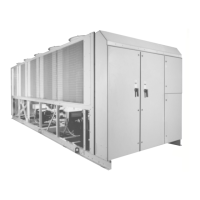
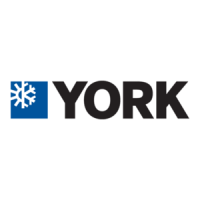


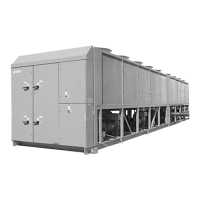
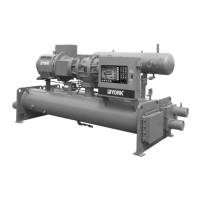



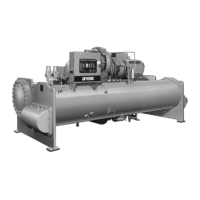

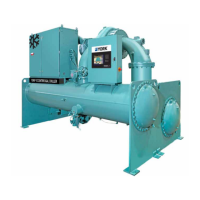
